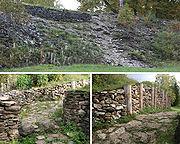
Varbola Stronghold
Encyclopedia

Circular rampart
A circular rampart is an embankment built in the shape of a circle that was used as part of the defences for a military fortification, hill fort or refuge, or was built for religious purposes or as a place of gathering....
fortress and trading centre built in Estonia
Estonia
Estonia , officially the Republic of Estonia , is a state in the Baltic region of Northern Europe. It is bordered to the north by the Gulf of Finland, to the west by the Baltic Sea, to the south by Latvia , and to the east by Lake Peipsi and the Russian Federation . Across the Baltic Sea lies...
, in Harju County in the 10th – 12th centuries. Parts of the ruins of the 580 metre long and 8-10 metre high limestone wall of the fortress stand til this day. The long gateways with multiple gates were built to defend the entrances. In these sections higher defensive towers were erected. There was a 13 metre deep well in the middle of the fortress and the territory held about 90 structures with furnace
Furnace
A furnace is a device used for heating. The name derives from Latin fornax, oven.In American English and Canadian English, the term furnace on its own is generally used to describe household heating systems based on a central furnace , and sometimes as a synonym for kiln, a device used in the...
s for accommodation built with limestone floors and foundations.
First mention
Henry of Livonia mentions the Castrum Warbole being besieged in 1211 for several days by Mstislav the BoldMstislav the Bold
Mstislav Mstislavich the Bold was one of the most popular and active princes of Kievan Rus' in the decades preceding Mongol invasion of Rus. He was the maternal grandfather of Alexander Nevsky and the prince Leo of Galicia....
of Novgorod. The conflict was resolved with a payment of seven hundred Marks
Mark (money)
Mark was a measure of weight mainly for gold and silver, commonly used throughout western Europe and often equivalent to 8 ounces. Considerable variations, however, occurred throughout the Middle Ages Mark (from a merging of three Teutonic/Germanic languages words, Latinized in 9th century...
.
Danish rule

Livonian Crusade
The Livonian Crusade refers to the German and Danish conquest and colonization of medieval Livonia, the territory constituting modern Latvia and Estonia, during the Northern Crusades...
Livonian Brothers of the Sword
Livonian Brothers of the Sword
The Livonian Brothers of the Sword were a military order founded by Bishop Albert of Riga in 1202. Pope Innocent III sanctioned the establishment in 1204. The membership of the order comprised German "warrior monks"...
invaded the territory and the people from Varbola asked for the terms of peace. The terms offered by Volquin
Volquin
Volkwin , also known as Folkwin, Volquin, and Wolquin, was the Master of the Livonian Brothers of the Sword from 1209 to 1236. Schenk is sometimes appended to his name....
, the Master of the Livonian Brothers of the Sword
Livonian Brothers of the Sword
The Livonian Brothers of the Sword were a military order founded by Bishop Albert of Riga in 1202. Pope Innocent III sanctioned the establishment in 1204. The membership of the order comprised German "warrior monks"...
were: accepting Christianity
Christianity
Christianity is a monotheistic religion based on the life and teachings of Jesus as presented in canonical gospels and other New Testament writings...
and giving hostages. The proposal was accepted by Varbolians. The hostages were freed at the request of the envoys of the Danish king Valdemar II who had taken control over Northern Estonia. They asked that the hostages be turned over to them, as part of Estonia already belonged to the king of Denmark since it was promised by the bishops of Livonia. Master Volquin, unaware of the promise, honored the king of Denmark and the request under condition that the rights of the Livonian Brothers of the Sword shall not be diminished thereby and returned the hostages to their fathers. Thereafter the people of Varbola became the subjects of the King of Denmark. On the basis of the Danish Census Book
Danish Census Book
The Danish Census Book or the Danish book of land taxation , from the 13th Century consist of notes for practical use in the Royal Chancery of Valdemar II containing a collection of information on Royal income and Royal land property. The book is one of the most important sources of information...
the estate surrounding the Varbola trading center remained a possession of the Lode family, nobility of Estonian origin at the time. The Danish king and his son Knut owned parts of the Lohu stronghold area, and the entire Keava stronghold area in Harju County.
Decline in 14th century
The Varbola stronghold lost its importance only in the second quarter of the 14th century, after having played in important part in the anti-Christian and anti-German St. George's Night UprisingSt. George's Night Uprising
St. George’s Night Uprising in 1343–1346 was an unsuccessful attempt by the indigenous Estonian population in the Duchy of Estonia, the Bishopric of Ösel-Wiek, and the insular territories of the State of the Teutonic Order to annihilate the Danish and German rulers and landlords, who had conquered...
of 1343.
Later history
In the 16.-17th Century the stronghold was used as a cemetery. The first known fort plan dates from 1786 and was drawn by Ludwig August von Mellin. Archaeological excavations at the site have been undertaken in 1938-41, 1953 and 1974. Among the archaeological finds were diceDice
A die is a small throwable object with multiple resting positions, used for generating random numbers...
made of bone.

